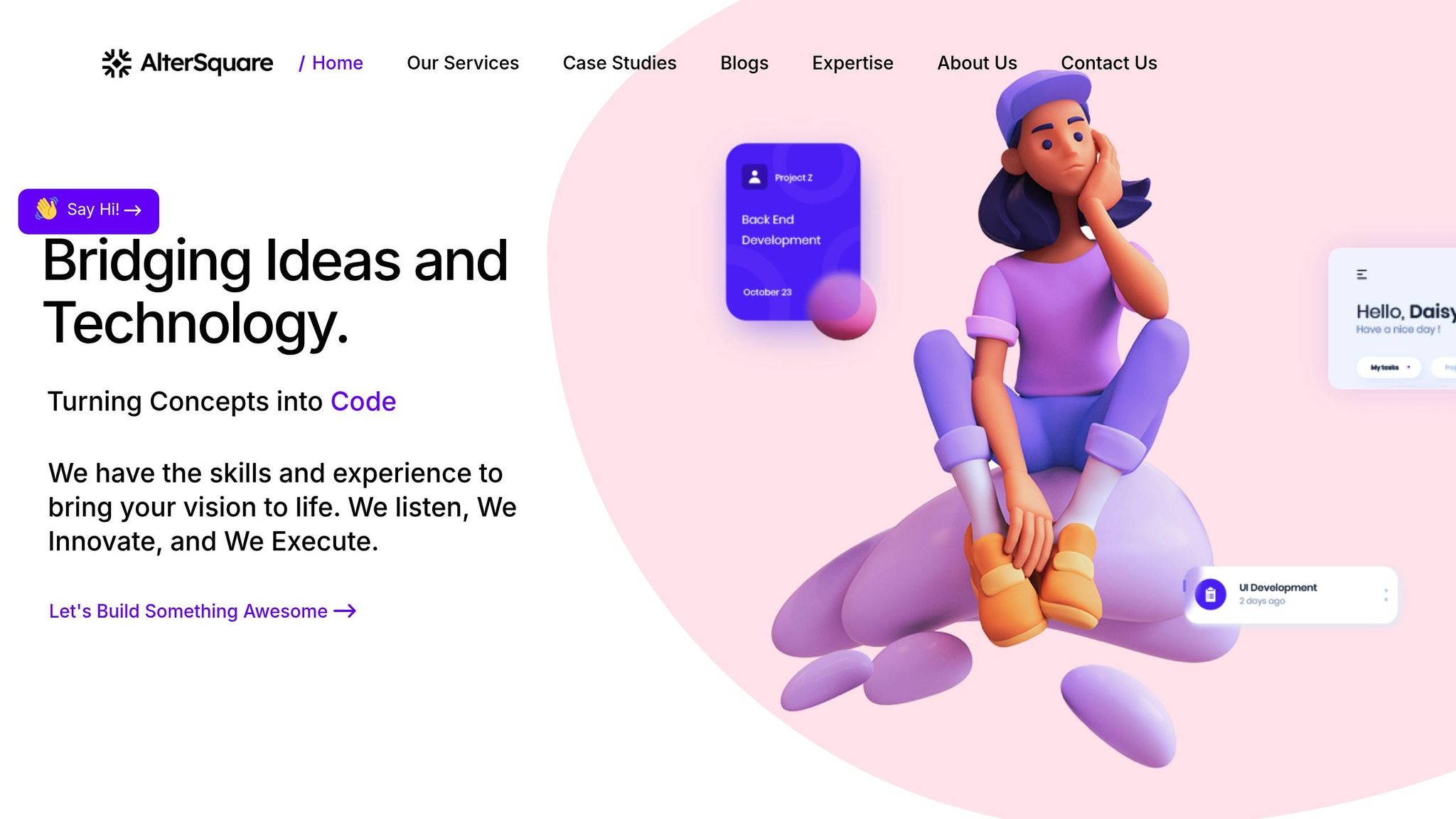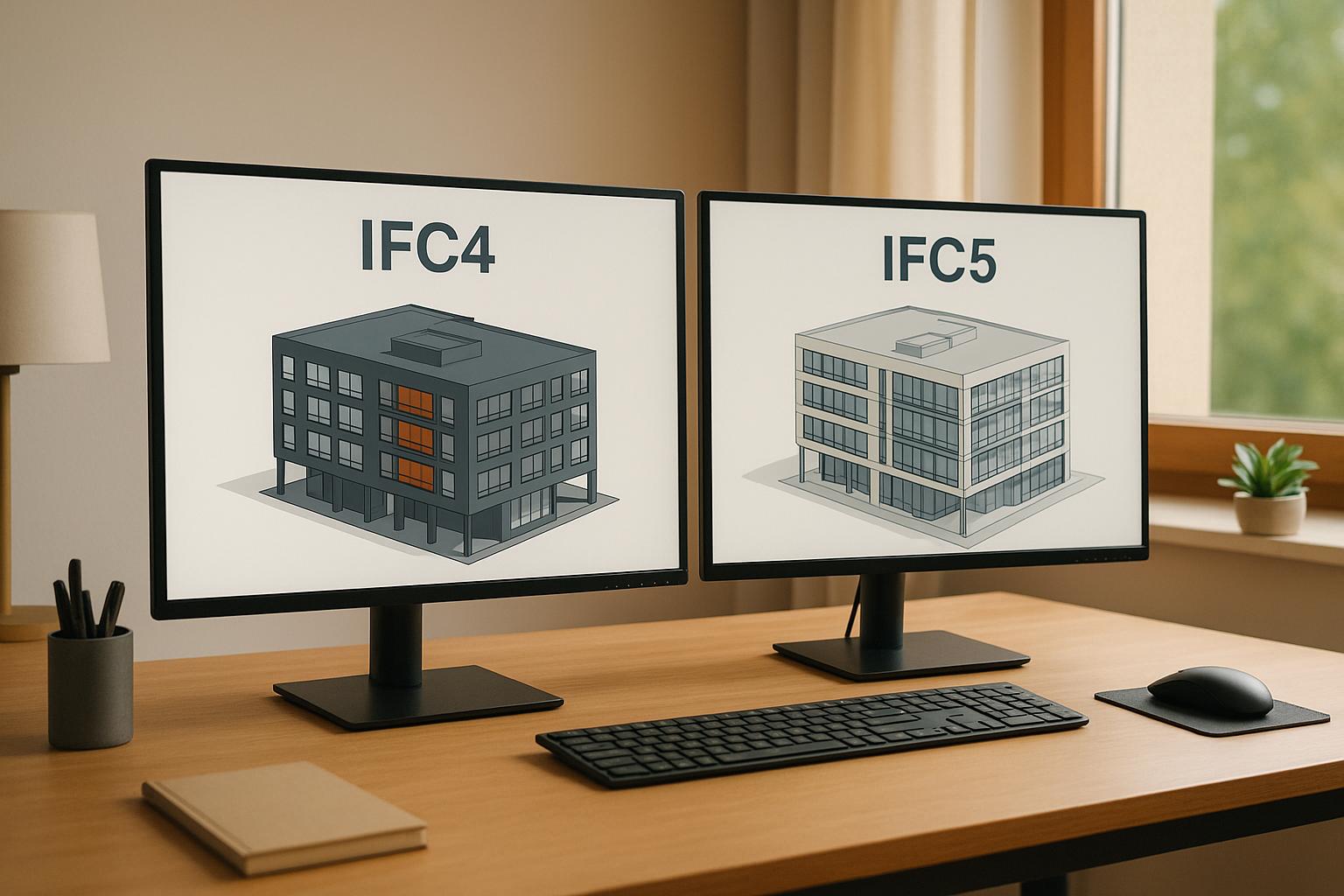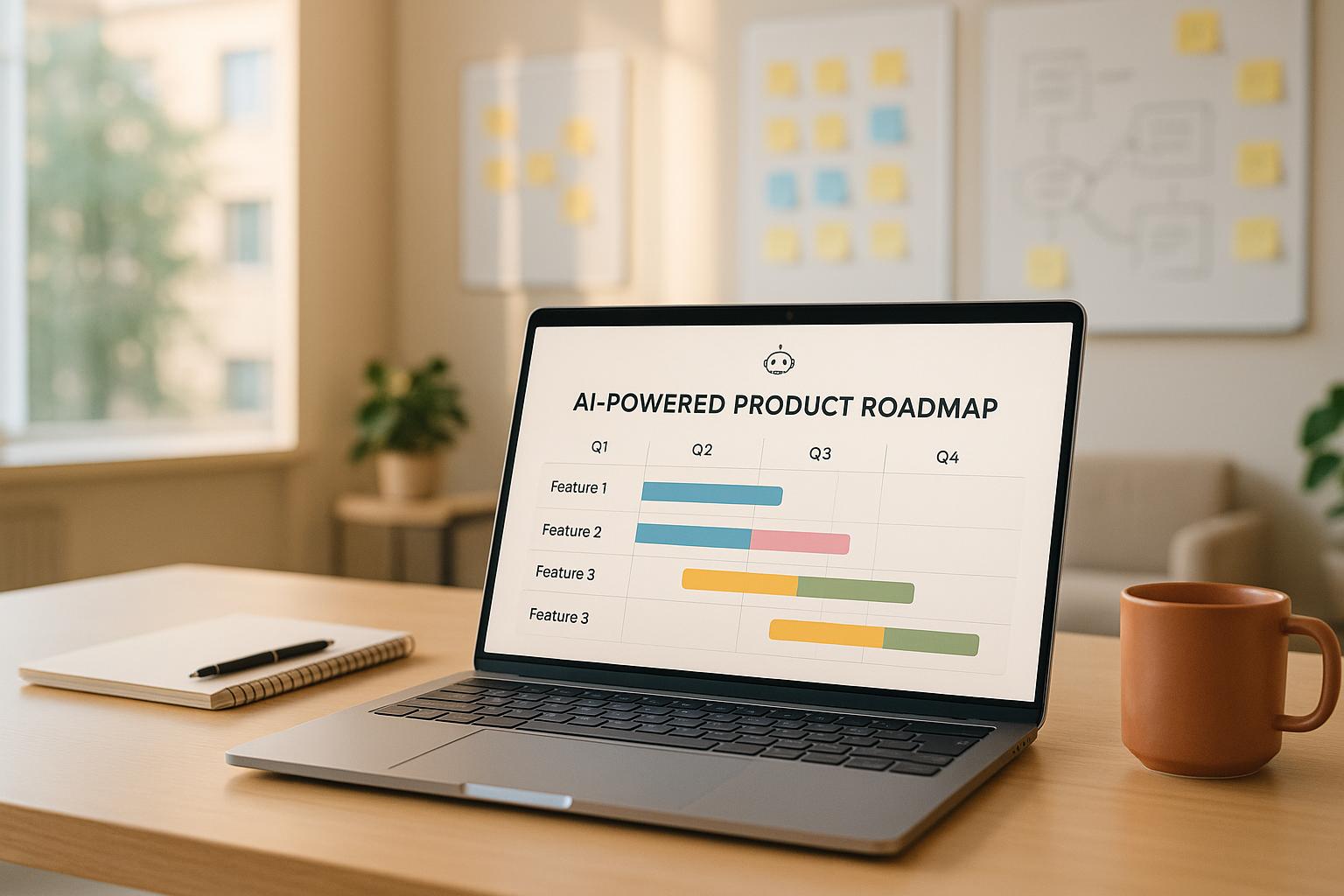The transition from IFC4 to IFC5 is a major shift for the Architecture, Engineering, and Construction (AEC) software industry. Here’s what matters most:
- IFC5 Highlights:
- Faster Implementation: JSON replaces the complex EXPRESS schema, reducing integration time from months to days.
- Modular Design: Component-based structure allows developers to work on specific features without handling the entire standard.
- Expanded Scope: Supports BIM, GIS, point clouds, and more, enabling broader applications.
- Incremental Releases: Early adoption is possible with phased updates.
- IFC4 Limitations:
- Complexity: Monolithic and procedural structure makes it harder to implement and scale.
- Interoperability Issues: Adoption is hindered by proprietary solutions and legacy systems.
- Cost Barriers: High integration costs and resource demands challenge smaller teams.
- Why This Matters for Startups:
- IFC5 simplifies workflows, promotes collaboration, and offers scalability for diverse projects.
- Transitioning requires planning, training, and resources to manage both standards during the shift.
Quick Comparison:
| Feature | IFC4 | IFC5 |
|---|---|---|
| Schema Design | Monolithic, STEP-based | Modular, JSON-based |
| Implementation Time | Months to years | Days |
| Geometric Handling | Complex, procedural | Simplified, triangular meshes |
| Supported Domains | BIM-focused | BIM, GIS, analysis, point clouds |
| Collaboration Model | File-based, single-author | Multi-author, distributed data |
| Scalability | Limited | Flexible with modular extensions |
Startups should carefully evaluate their roadmap to decide when and how to make this transition. IFC5 offers a clear path forward for those ready to embrace its streamlined approach.
Don’t stress about IFC 5 yet! Here’s why IFC4 (and IFC4x3) still matters
IFC4: Core Features and Current Limitations
Introduced in March 2013 and standardized as ISO 16739:2013, IFC4 has become a key element in modern BIM workflows. For U.S. startups, understanding its strengths and weaknesses is essential for making informed architectural and business decisions.
Key Features of IFC4
IFC4 builds on the foundation of its predecessor, IFC2x3, by addressing several technical gaps and enhancing data exchange capabilities. Here’s what makes IFC4 stand out:
- Improved Geometric Representation: It supports complete boundary representations (B-rep), b-spline surfaces, and curves, allowing for more detailed and precise geometric modeling.
- Parametric Shape Exchange: Enables the exchange of parametric data for building elements, including shapes, materials, and types, offering flexibility in how components are defined and adjusted.
- Standardized Quantities: Introduces a consistent framework for measurement and estimation, simplifying the development of accurate quantity takeoffs.
- Simulation-Ready Features: Native support for energy modeling and simulations makes IFC4 a strong choice for startups prioritizing sustainability and performance analysis.
- Enhanced Project Management Tools: Streamlines 4D scheduling with refined task times and calendars, while integrating cost management directly into 5D workflows.
- Infrastructure Compatibility: Broadens its scope to include infrastructure projects such as bridges, railways, and roads.
- Stronger Interoperability: Improves BIM-to-GIS data exchange and connects with the buildingSMART Data Dictionary, enabling workflows in local languages and classifications.
Challenges with IFC4 Adoption
Despite its advancements, adopting IFC4 comes with several hurdles that startups must navigate:
- Limited Practical Interoperability: While IFC4 aims to enhance data exchange, real-world adoption for seamless collaboration remains limited. Proprietary solutions still dominate BIM workflows, restricting its full potential.
- Cost Barriers: According to the U.S. National Institute of Standards (NIST), inefficiencies in IT interoperability cost the U.S. capital facilities industry $15.8 billion annually. Additionally, software non-interoperability consumes about 3.1% of project budgets [4].
- Complexity and Resource Constraints: Startups often lack the skilled personnel, financial resources, and technical infrastructure needed to implement IFC4 effectively.
- Legacy System Issues: Many older systems struggle to integrate with IFC4, and the high upfront costs of new software licenses add another layer of difficulty.
- Market Resistance: Resistance to change, combined with skill shortages, budget limitations, and data security concerns, slows the adoption of new technologies across the industry.
- Competitive Pressures: Larger, more established companies with greater resources often outpace startups, making it harder for smaller players to fully leverage IFC4.
While IFC4 offers a wide range of features that can enhance interoperability and project management, startups need to weigh its benefits against the challenges of implementation. Careful planning and resource allocation are crucial to integrating IFC4 into their workflows and staying competitive in the evolving AEC landscape.
IFC5: New Features and Improvements
IFC5 takes a bold step forward by addressing the limitations of IFC4, offering a modular design that reimagines how building information is exchanged. Unlike the incremental tweaks of its predecessor, IFC5 introduces a completely overhauled architecture aimed at tackling the core challenges faced by startups developing interoperable AEC software.
What’s New in IFC5?
One of the standout changes in IFC5 is its component-based design, which breaks objects into smaller, independent parts. These components can be combined and reused, making it far easier for development teams to implement specific features without having to grapple with the entire standard.
Another major shift is the adoption of JSON as the primary serialization format, replacing the more complex EXPRESS schema. This change drastically reduces the time needed for implementation, cutting it down from months – or even years – to just days [1]. Startups can now integrate IFC5 into their workflows much faster.
Geometry handling has also been simplified. By focusing on triangular meshes and allowing elements to inherit data from typical components, IFC5 reduces the complexity that often overwhelmed smaller teams. This makes it easier to develop tools like viewers, editors, and analysis software without getting bogged down by intricate geometric representations.
Additionally, IFC5 introduces incremental release cycles. Instead of waiting for a fully developed standard, buildingSMART will roll out IFC5 in stages, starting with a "reduced" version that includes basic functionalities. Regular updates will add new modules over time [1]. This phased approach allows startups to start implementing earlier and adapt as the standard evolves.
The scope of IFC5 has also expanded, supporting a wider range of applications beyond traditional BIM workflows. It now accommodates BIM, GIS, analysis, project version management, and even non-modeled data like point clouds [1]. For startups targeting diverse markets, this means a single implementation can address multiple customer needs, paving the way for greater flexibility and scalability.
How IFC5 Improves Interoperability and Scalability
IFC5 is built with collaborative data construction in mind. Léon van Berlo, Technical Director at buildingSMART International, explains:
"The principle of IFC 5 is that multiple users contribute pieces of data to the overall dataset" [5].
This collaborative approach tackles the workflow limitations that hindered IFC4 adoption.
The component-based architecture significantly enhances scalability. Applications no longer need to load entire building models into memory; instead, they can work with specific components as needed. This allows startups to create products that can handle both small residential projects and large infrastructure developments without requiring fundamental changes to their software architecture.
IFC5 also ensures rigorous standardization, addressing the ambiguities of earlier versions. By defining a single, correct way to represent data, it eliminates compatibility issues between different software implementations [1]. For startups, this means less time spent troubleshooting interoperability problems and more time focusing on product innovation.
Another exciting prospect is the potential integration with Universal Scene Description (USD). While IFC5 and USD are separate standards, IFC5 could leverage USD principles for managing large-scale models and incremental updates [1]. This opens the door for startups to tap into USD-compatible tools, enhancing their visualization and analysis workflows.
Holger Kreienbrink, Director of Product Intelligence and Partnerships at Graphisoft, highlights the collaborative progress:
"These meetings show that by working through buildingSMART, even competitors can move forward together on the shared goal of interoperability. IFC 5 will be a big step forward and opens new possibilities" [5].
Potential Challenges in Transitioning to IFC5
While IFC5 brings significant advancements, it also introduces challenges that require careful planning and effort.
The architectural overhaul means existing IFC4-based codebases won’t simply upgrade. Developers will need to rebuild data-handling logic to align with the new component-based system, which demands a substantial engineering investment.
Additionally, toolchain updates will be necessary across the board. Libraries, testing frameworks, and deployment tools that currently support IFC4 may need to be replaced or significantly modified to work with IFC5.
The component-based approach also introduces new complexities. Developers must learn new data structures and validation methods, while product managers, QA teams, and support staff will need to understand how these changes impact workflows and user experiences.
The incremental release strategy presents another challenge. Startups must decide whether to adopt the initial "reduced" version or wait for a more complete release. Jumping in too early could mean reworking features as the standard evolves, while waiting too long risks falling behind competitors.
Finally, market timing is a critical consideration. Since IFC5 adoption will be gradual, startups must maintain compatibility with IFC4 while building IFC5 capabilities. Supporting both standards simultaneously can strain resources and complicate product development plans.
Despite these hurdles, the long-term benefits of IFC5 – greater interoperability, scalability, and flexibility – position it as a valuable investment for startups aiming to thrive in the evolving AEC software landscape. By embracing this new standard, companies can prepare to meet the demands of a rapidly changing industry.
sbb-itb-51b9a02
IFC4 vs IFC5: Direct Comparison for Startup Teams
Understanding the differences between IFC4 and IFC5 is essential for shaping your product roadmap. While IFC4 is well-established, IFC5 introduces a fresh approach to data structure and sharing.
IFC4 vs IFC5: Key Feature Comparison
Here’s how these two standards differ and how they influence startup development and scalability:
| Feature | IFC4 | IFC5 |
|---|---|---|
| Schema Design | STEP-based, monolithic structure with strict inheritance | Language-independent, component-based with Entity Component System (ECS) |
| Data Format | EXPRESS schema with complex serialization | JSON as primary format for easier implementation |
| Geometric Handling | Procedural and complex geometric definitions | Triangular meshes for simplified geometry processing |
| Supported Domains | Primarily BIM workflows | BIM, GIS, analysis, version management, point clouds |
| Collaboration Model | File-based exchange, single-author focused | Multi-author collaboration with distributed data construction |
| Scalability | Limited by monolithic architecture | Modular core with optional extensions |
It’s worth noting that IFC4.3 includes over 1,300 entities. David Delgado Vendrell, Technical Coordinator of buildingSMART Spain, highlights the evolutionary nature of the shift to IFC5:
"The transition to IFC5 should be understood as a natural evolution rather than a disruptive revolution, where maintaining the balance between innovation and stability is fundamental" [2].
These distinctions play a critical role in how startups approach MVP development and long-term scaling.
Impact on MVP Development and Scaling
Choosing between IFC4 and IFC5 impacts your product’s foundation from the outset. For MVPs, IFC5’s simpler implementation allows your team to focus on delivering core functionality without getting bogged down by a complex schema.
IFC5 introduces role-based modeling, focusing on object functionality rather than rigid inheritance. This flexibility makes it easier to tailor the standard to your specific use cases without being locked into predefined classifications.
By contrast, IFC4’s monolithic design demands full integration, which can complicate scaling efforts. In comparison, IFC5’s modular structure enables you to roll out core features first and add capabilities incrementally. Its multi-author collaboration model also opens the door to real-time workflows, unlocking new opportunities for product innovation.
Beyond design and scalability, implementing these standards in the U.S. market brings its own set of challenges.
Localization Considerations for U.S. Startups
For startups operating in the U.S., localization is a key factor when adopting IFC4 or IFC5. American construction practices rely heavily on imperial units – feet, inches, pounds per square inch – making seamless unit conversions a top priority.
IFC4’s procedural and complex geometric definitions often complicate unit conversions, especially when models combine multiple measurement types. In contrast, IFC5’s triangular mesh approach standardizes geometric representation, making it easier to handle units consistently across all elements and reducing the risk of conversion errors.
Date and time formatting is another critical factor. U.S. construction schedules typically follow the MM/DD/YYYY format, and project timelines often reference specific time zones. IFC5’s JSON-based framework simplifies localized date handling compared to IFC4’s more rigid EXPRESS schema.
Regulatory compliance adds yet another layer of complexity. Building codes in the U.S. vary widely between states and municipalities, requiring adaptable data models. IFC5’s modular design makes it easier to extend the standard with region-specific properties without altering the core schema. Its broader range of supported use cases also aligns well with the diverse regulatory environment, where GIS integration is often essential for zoning, environmental assessments, and infrastructure planning.
Temperature handling is another consideration. While most engineering calculations use Celsius, U.S. construction professionals typically work in Fahrenheit. IFC5’s component-based architecture allows for consistent handling of temperature units across various systems, from HVAC design to thermal analysis.
How to Transition to IFC5 with AlterSquare

Shifting from IFC4 to IFC5 takes careful planning to ensure workflows are updated and teams are trained without causing disruptions.
When to Adopt IFC5
If you’re starting a new MVP, IFC5’s improved interoperability and simplified management make it a strong choice right out of the gate. For startups already working with IFC4, your current efforts won’t go to waste. As David Delgado Vendrell, Technical Coordinator of buildingSMART Spain, explains:
"Organizations currently investing in IFC4.x implementations should feel confident that their efforts will not be in vain, as these implementations will form the basis upon which the future of IFC will be built" [2].
Consider adopting IFC5 when launching new products or planning significant updates to stay competitive. If you’re deeply invested in IFC4, transitioning in phases can help maintain continuity. Once you’ve mapped out your strategy, focus on preparing your team and workflows for the change.
Preparing Your Development Team and Workflow
Switching to IFC5 means updating your technical infrastructure, training your team, and refining workflows. Start by pinpointing critical integration areas [6].
Your development team should familiarize themselves with the key differences between IFC4 and IFC5, particularly how these impact data relationships and system architecture. Establishing clear processes and workflows is crucial before selecting tools to support the transition [7].
Provide targeted training through workshops, mentorships, and incentives to encourage quick adoption [6]. As Deltek puts it:
"People are more likely to adopt something new if they can see how it helps them to better achieve their day-to-day goals and objectives – making them more productive" [3].
Create a detailed roadmap with specific milestones and data exchange protocols [6]. Running a pilot project can help your team gain hands-on experience with IFC5 and address any challenges early on.
Using AlterSquare for Smooth Integration
Once you’ve laid the groundwork, AlterSquare can help streamline the integration process. Their I.D.E.A.L Delivery Framework promises a structured approach to adopting IFC5, enabling implementation within 90 days while reducing risks and maintaining development speed [3]. This framework is particularly useful for startups balancing innovation with operational demands.
AlterSquare specializes in modernizing outdated systems without disrupting ongoing operations, making it well-suited for IFC5 transitions [3]. Their phased methodology allows for gradual adjustments, minimizing interruptions [3].
With the I.D.E.A.L Delivery Framework, AlterSquare reconfigures system architecture for scalability, enhances performance without halting workflows, and ensures new tools align with existing systems – all within a 90-day timeline [3]. The team emphasizes open standards for seamless data sharing and offers practical training programs to address both immediate and long-term needs [3].
Conclusion: Preparing for the Future with IFC5
The transition from IFC4 to IFC5 isn’t just about adopting new technology – it’s about creating opportunities for startups to develop scalable and interoperable solutions. IFC5 simplifies processes through its use of JSON and a modular, component-based design, while also supporting integration with Universal Scene Description (USD). This modular approach allows you to prioritize essential features first and add more as your needs grow, thanks to its phased implementation.
To fully take advantage of these advancements, it’s crucial to prepare your team. Make sure they are well-versed in JSON and understand the ins and outs of IFC5’s modular framework. With the right skills in place, your team will be ready to make the most of what IFC5 has to offer.
FAQs
What are the main differences between IFC4 and IFC5, and how do they affect startups in the AEC industry?
The shift from IFC4 to IFC5 brings notable improvements in how data is shared, managed, and scaled, offering startups in the AEC industry a chance to optimize their workflows and grow more effectively. With features like flexible and asynchronous workflows – drawing inspiration from concepts such as USD layers – IFC5 helps minimize delays in collaborative projects by simplifying otherwise complex processes.
Another key benefit of IFC5 is its inclusion of more optional attributes, which creates a more streamlined and efficient environment for BIM operations. For startups, this translates to smoother data exchanges, better support for architectural decision-making, and improved scalability over time. These advancements make IFC5 an essential element to consider when planning your product’s future development.
What steps can startups take to smoothly transition from IFC4 to IFC5 without disrupting their workflows?
Startups can make the shift from IFC4 to IFC5 smoother by emphasizing early preparation and a step-by-step rollout. Start by educating your team on the key changes and advantages of IFC5, like better interoperability and scalability. This ensures everyone is on the same page about how the new standard will influence workflows and align with your product objectives.
Next, integrate IFC5-compatible tools into your processes and adjust your development practices to match the updated standards. Begin with smaller, low-risk projects to test the waters before expanding its use across critical areas. Keep an eye on updates from industry leaders and relevant organizations, and weave these insights into your planning to stay ahead. Taking it one step at a time will reduce disruptions, help your team adjust seamlessly, and keep productivity steady.
How can startups successfully adopt IFC5 while managing its incremental updates and new features?
To bring IFC5 into your startup’s operations successfully, it’s important to take a step-by-step approach. Start by making sure everyone involved understands the advantages and changes that come with adopting IFC5. Clear communication with stakeholders helps align expectations and prepares your team for what lies ahead. Hosting training sessions or workshops can also be a great way to equip your team with the skills they’ll need to make the most of the new standard.
Introducing IFC5 gradually is a smart way to reduce risks. Begin with smaller, low-stakes projects to explore and adapt to the new features before rolling it out across your entire workflow. Identifying early adopters within your team can be especially helpful – they can pinpoint potential challenges and help fine-tune the process. Offering continuous support and keeping open lines for feedback will also make the transition smoother and set the stage for long-term success with IFC5.









Leave a Reply